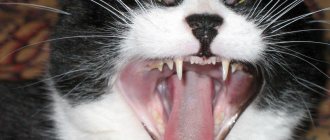History of Pied Pipers
The domestication of cats occurred in Egypt approximately 9 thousand years BC. e. In those days, the grain harvested from the fields was eaten by mice and rats. People saw how cats hunted them and began to lure and tame the nimble hunters. Since then, these animals have taken their place next to people, ridding them of rodents. For such merits, cats were called sacred animals, protecting food supplies and saving people from hunger. Since ancient times, cats have been given special honors, and high fines were imposed for killing them. The cost of a clever rat-catcher cat was equal to the cost of an ox.
Agile rat-catching cats in the old days were worth as much as an ox
There is a legend that says that during the global flood, rodents appeared on Noah’s Ark, dangerous to the inhabitants. Then cats were born from the lions, destroying all the rodents and saving the animals on the ship from them.
Cats conscientiously performed their duties in peasant homes, in monasteries, and at the royal court. Peter I ordered the adoption of cats to protect barns from the invasion of mice and rats. By order of Elizabeth, his daughter, 30 rat-catcher cats were brought to the Winter Palace from Kazan, the city where the most dexterous rat-catchers were believed to live. During the reign of Catherine II, cats appeared in the Hermitage to protect works of art from rodents.
During the siege of Leningrad, cats saved residents and the city itself 2 times. When, in the first years of the siege, all the animals were eaten due to hunger, many rodents appeared in the city, and the Winter Palace was simply swarming with them. To combat dangerous rodents, 5 thousand smoky cats were brought from Yaroslavl to Leningrad in April 1943, then a train of Siberian cats arrived, and soon rodents disappeared from the city.
Cats still regularly serve in the Hermitage, protecting the country’s cultural heritage from rodents and forming an integral part of museum life; they are its unique symbol. Museum employees say that throwing cats out into the street is like throwing a painting by an outstanding artist from the 10th floor.
Cats in the Hermitage protect the country's cultural heritage from rodents
Infinity War: Cats vs. Rats. Part 1.
"World Domination"
It's hard to believe, but the rat race appeared 50 million years ago - along with many animals that have long been gone. Its age is almost 25 times greater than that of humans and there are 97 species. The most dangerous of these species is the gray rat or, as it is otherwise called, pasyuk. He first appeared in Eastern China, from where he set off on a trip around the world. Even the world's largest rivers - the Volga, Yenisei, Lena, and Nile - were caught in the teeth of the rodent. Using human achievements, he easily crossed the seas and oceans. The holds of the ships were infested with rats - they, and not humans, were the first to set foot on new lands. The Age of Discovery is a time of massive expansion of rats. Today, only Antarctica and certain Arctic islands are free from them. For every resident of other territories there are an average of two rats. This means that man did not win the centuries-old struggle against them. Why?
We had lunch... with the king
Unlike humans, who changed the environment “to suit themselves,” rats of the millennium adapted to it. This is probably where their unique biological characteristics come from. Almost incredible, for example, is the omnivorousness and endurance of rodents. They do not disdain bark, wood, book glue, oiled paper, bones, and all kinds of food waste. “For a rainy day,” rats create reserves: in their burrows up to 15-25 kilograms of carrots, 4-6 buckets of potatoes, 38 large eggs and even about 3 kilograms of dumplings were found. Pasyuki are not averse to eating flesh, including live flesh. It is known, for example, that they “feasted” on prisoners in dungeons and even killed three kings. In terms of endurance, rats can give odds to the most “tenacious” representatives of the fauna. There have been cases of rodents making nests under steam boilers. And the heat in such “tropics” reaches as much as 50 degrees! Low temperatures are not scary for hardy bees. In freezers (at minus 11!) the animals even managed to reproduce. Rats also react very specifically to radioactive radiation. A sensation was caused by scientists' visit to one of the atolls in the Pacific Ocean, where the Americans tested atomic weapons. A few years after the explosions, a radioactive desert was discovered there. There were no hints of any traces of living things - flora or fauna. The exception was the Pasyuki, for whom nuclear “mushrooms” only benefited. The new owners of the atoll were much larger and more resilient than the previous ones. According to scientific evidence, rats are susceptible to X-rays. Moreover, here they are also one of a kind! Of all the animals to whom the beam of rays was directed, only pasyuki woke up! There is a version about the special connection of rats with space. Doesn’t this explain the unique “sensitivity” of animals to natural disasters? After all, they are not only the first to flee from sinking ships, but also abandon their homes before earthquakes. Maybe they receive alarm signals from space?...
One head is good, but many are better
Russian biologist Nina Smirnova, who has studied the behavior of pasyuks for a long time, claims that they are characterized by ... collective intelligence. And he, in turn, controls the actions of each individual. This hypothesis explains, for example, the presence of “scouts” and “tasters” in rats. The first were identified as a result of experiments when the animals were placed in a new room for them. These “apartments” created ideal living conditions. The “service” included hearty food, suitable air temperature, and an ideal ratio of males and females. As they say, live for yourself and multiply! However, in each group of experimental rats, male “scouts” or “pioneers” stood out. They stormed a special hole made into the adjacent room. According to the conditions of the experiment, the hole was located at a decent height from the floor, strewn with broken glass and strewn with exposed electrical wires. But all this did not stop the scouts! Moreover, in several experimental groups of rats, the percentage of “pioneers” in relation to other individuals was the same. The behavior of the so-called “tasters” seems no less surprising. Despite being indiscriminate when it comes to food, Pasyuki are wary of new food. They never attack her all at once. For this purpose, there is a “taster” who tries the food alone. His brothers watch the meal and wait for the results of the “experiment.” Rats start eating only if the “taster” remains safe and sound.
Gray wise guys and smart girls
Do rats, in addition to the collective mind, have an individual mind? The answer to this far from paradoxical question is provided by numerous observations. One of the biologists monitored the behavior of a pasyuk that settled in a birdhouse. Every morning the rat went down to the river to have breakfast. To do this, she pulled out a frog, numb from the cold, from the hole. Then, leaving the prey on the ice, the pasyuk went to its “house” to warm up. After that, he returned to the river and took the “breakfast” into the birdhouse. At the end of the last century, Larisa Darkova, the head of a department in one of the Moscow departments of the disinfection service, told journalists an amazing story. For several nights she watched rats in the basements of the famous Eliseevsky store. “I was trying to understand how they manage to steal eggs without breaking them. In order not to damage the shell, these clever people came up with the following: one rat lies on its back and rolls a chicken egg into the hollow formed on its stomach with its muzzle. At this time, another “accomplice” grabs her by the tail, and thus they drag the eggs into the hole.”
Rats are noticeably “getting smarter” - these are the results of observations of them in recent decades. How can we explain this amazing phenomenon? Pasyuki living in cities are exposed to all kinds of radiation, poisoned by gases and heavy metals. Perhaps such extreme conditions (remember the mutants of the Pacific atoll) “spur” the evolution of rats. However, there is one more assumption about this. “There is a version,” one of the Russian newspapers once reported, “that very smart rats did not appear in our cities by chance, but thanks to the activities of various special laboratories. In many of them, before the start of perestroika and the associated destruction of science, very interesting results were achieved, which then could have fallen into not entirely clean hands. And suddenly a new civilization has already arisen next to us - a civilization of rats, whose year is equal to a human century? ...A very interesting discovery was made by a group of American scientists from the University of Bowling Greens (Ohio). After a whole series of experiments, they proved that rats can... laugh. Surely, isn’t it us – Homo Sapiens – who are making fun of the gray smart guys and smart girls? Doesn’t it make them laugh that man is convinced that he is the King of Nature?
What about Nature itself? Which animal did she create “as opposed to” the ubiquitous, omnivorous and obviously intelligent rats? There is a legend according to which the Creator breathed life into these rodents, but forgot about the cats. Because of this, rats almost sank Noah's Ark by gnawing at the bottom. And then Noah tickled the lion's nose. The king of beasts sneezed, and a pair of cats flew out of his nostrils. The Ark was saved!
(Continued - part 2).
All illustrations were found on the Internet.
Material prepared by Natalia (Barcelona)
General features of rat catchers
The rat catcher is not a separate breed of cat, it is the valuable quality of the animal, the sharpness of its hunting instinct. According to felinologists (specialists in breeding cats), rat-catching cats can be identified by the following characteristics:
- muscular body, powerful jaws, strong legs;
- head shape - there is a relationship between the genes responsible for the instincts of hunters and the genes that determine the configuration of the skull of cats: rat-catching abilities are observed in animals with a triangular head (oriental type of cats);
- lush mustache and high ears with tassels at the ends: they allow animals to detect possible rustles, and this is very important for a successful hunt.
Ratcatcher cats usually have large ears that can detect the smallest noises.
Some rat hunters may be affectionate in nature, while others may be unsociable. There are animals that want to please their owner and often catch rats to show him their love. And there are cats that avoid people and do not welcome affection, but this is also quite normal.
How to choose the right kitten
When choosing a future rat catcher, you need to take into account the following characteristics of the animal:
- Body type. A furry hunter must be able to take on a large rodent, so he must be big himself. Requirements for a rat catcher: large, powerful body, developed muscles, powerful, wide bones, strong paws, general stockiness. It is important that the size of a cat is determined by the state of its muscles, and not by the amount of fat.
- Floor. Among males, rat catchers are a rare occurrence. Cats are usually good hunters. This can be explained by the need for females to feed their offspring, teach kittens, and protect them.
- Game method. If you need a cat as a rat catcher, you should check how it behaves with a furry toy mouse. Potential hunters rush at the toy and grab it with their teeth, gnawing it. Ordinary fluffies just play with the mouse with their paws.
- Head shape. To make sure that the cat’s skull is triangular, you need to carefully feel it by pressing the cat’s ears.
- External signs. Ratcatchers often have large, tufted ears. It is better to choose a striped or tri-color color. In this case, it will be easier for the hunter to disguise himself.
It is almost impossible to raise a rat catcher on your own. Therefore, when choosing a kitten, you should pay attention to the list of breeds that have special hunting instincts.
Recommended Posts
The main stages and duration of pregnancy in cats
Character and appearance of the Neva masquerade cat
Caring for a Scottish Fold cat during pregnancy
Overview of the Celtic or European Shorthair Cat Breed
Description of 9 cat breeds with big ears
Features of care and feeding of the Scottish fold cat
Breeds of rat-catching cats
There are certain breeds in the cat family, whose representatives are distinguished by excellent health, special dexterity and dexterity in catching rats.
Siberian cat
The cat was named Siberian due to its fluffy long hair. She is unpretentious, has a strong build, the weight of cats reaches 7 kg, cats weigh about 9 kg. She has strong paws and excellent grip. Due to the slightly longer hind legs compared to the front legs, the cat has the ability to run and jump quickly. Such animals are obstinate in nature, they have an excellent reaction, which is necessary when catching rats. They are independent and love freedom.
The Siberian cat has a strong build and excellent grip.
To maintain the desired shape, Siberian cats require regular walks in the fresh air.
Maine Coon
Cats of this breed are distinguished by mobility and strength. Maine Coons are hardy and able to live in regions with harsh climatic conditions. These large animals (males can weigh up to 15 kg) have the nature of a predator; they do not welcome human affection. Due to their size, they can easily deal with rats.
Maine Coons easily deal with rats
This breed of cat is distinguished by straight-set large ears, which have tassels at the ends. Maine Coons have long and thick fur. They have well-developed muscles, a wide chest, strong bones, and a thick and long tail. All this data allows Maine Coons to become a real threat to rodents.
Kurilian Bobtail
A feature of animals of this breed is a short tail, the length of which does not exceed 3–8 cm. But they have strong hind legs, which are longer than the forelimbs. And therefore the Kurilian bobtail runs well, jumps, and deftly strangles rats. Males of this breed weigh about 10 kg, females - 6 kg.
The Kurilian Bobtail is fearless and deftly strangles rats
Such cats are capable of completely destroying a mouse or rat hole. They are easy to train and can be trained. People keep them as companions; they get along easily with other animals. Bobtails have a fearless character.
European shorthair cat
Representatives of this breed destroyed rodents back in the days of Ancient Rome. European shorthair cats are called yard cats and are not considered purebred. However, they are popular in the world and are one of the best rat catchers. The predator's passion and agility help them successfully hunt rats and mice.
European shorthair cats are some of the best rat catchers.
Such cats are distinguished by individuality, independence, grace, and aristocratic appearance. They have a short coat, gray or silver marbled in color.
European cats get along well with people and are non-aggressive. They love to play, but do not completely obey their owner.
Cymric
Animals of this breed are similar to ordinary cats, but with a short tail. This structure, along with agility and tenacious claws, makes the Cymric a successful rat catcher.
Agility and tenacious claws make the Cymric a successful rat catcher.
It is good to keep these cats in private homes with open areas, as the animals require regular walks in the fresh air, freedom of movement, and physical activity.
British Shorthair
The hunting instinct and excellent natural inclinations make the British excellent rat catchers. Such cats are calm, friendly, and attractive in appearance. They love to please their owner by bringing him a caught rodent in their teeth in order to exchange it for rewards and something tasty.
Natural inclinations and hunting instinct make British Shorthairs excellent rodent catchers.
Females, weighing an average of 4 kg, try not to attack large rats, hunting only young ones or mice. Often this is enough to avoid a rodent infestation.
Russian blue
Russian blue cats are medium in size and light in weight, but this does not interfere with their hunting habits. Instant reaction and silent movement for a long time make these cats good rat catchers.
The Russian Blue cat has the ability to move silently and react instantly.
The ability of the Russian Blue to react to rodents is a true art: its speed of attack on the prey, accuracy and grace of movements are captivating. This is a thunderstorm of super rats, weighing about 500 g. The Russian Blue does not like partners of other cat breeds, but gets along well with rat catchers of its own breed.
Opponent of tenderness from the owner.
Siberian cat
Representatives of the Siberian breed are distinguished by their willfulness. But this does not stop them from hunting rats in the area. They prefer to walk as often as possible, so cleaning the area from pests is guaranteed.
Siberian cats become quite large as they grow older. They run fast and jump far. The strongest part of their body is their paws, so rats caught in them will not be able to escape from captivity. Despite their success in hunting, Siberians have a character that is difficult to get along with.
Features of care and maintenance
A real rat catcher can be raised from a small kitten. You just need to use some tips:
- To maintain the hunting instinct, the animal should be given food in small portions at least 5-6 times a day. To prevent the cat from becoming lazy, it should not be overfed. Food should not be in the bowl all the time, but the cat should not be left hungry either, since the rat hunter will need strength to attack the rodents.
- It is necessary to cultivate a hunting sense in the future rat catcher, praise and encourage him for any prey he catches: a bird, a mouse, a fly.
- It is difficult for a person to raise a kitten to be a rodent hunter, and therefore there is no need to separate it from its mother cat for up to 5 months so that during this time she can teach him the necessary skills.
- The pet must lead an active lifestyle; it requires not only toys in the form of balls, mice, bows, but also special play complexes.
The gaming complex will help your pet maintain an active lifestyle
- Rat catchers need to be vaccinated against rabies to boost their immunity, since rats are aggressive animals. When cats receive wounds from rodents, the damaged areas must be carefully treated and consulted with a veterinarian.
Otherwise, the care and maintenance of rat catchers is no different from the care of ordinary cats.
What breeds can be called mousecatchers?
All representatives of the cat world are initially inclined to catch mice, regardless of color, color or breed. This instinct is inherent in them by nature itself. But not all pets can fully realize it.
The most professional mousecatchers are considered to be yard and street animals, the breed of which cannot be distinguished due to numerous mixtures. Their hunting efficiency is not due to their breed, but to their lifestyle.
Frequent hunger provokes animals to go out every day and several times to obtain food. Therefore, their skill and experience are not comparable to their domestic counterparts.
The Turkish Angora is considered an excellent mouse catcher.
The best mousetraps are easily identified by external inspection.
The muscles of potential mouse catchers should be well developed and not overweight. The hunter's head is necessarily triangular in shape.
If we compare purebred cats, then the most dexterous mousecatchers are recognized as:
- European Shorthair
- European tabbies
- European speckled
- Turkish Angora
Their success is determined not only by the shape of the head and body composition, but also by color. Thanks to its colors and prints, the hunter can easily disguise herself and ambush rodents.
European breeds are considered to be all types of pets with short hair that live at home in European countries.
There are currently no separate breeds of mousecatchers. However, breeders and scientists around the world are trying to breed the ideal mouse hunter by crossing more adapted breeds of felines.
Ratcatcher cats for rent: where to find, cost
Buying a real rat catcher is quite difficult: you can be deceived for a lot of money. However, in some cities it is possible to rent a cat. You should know that ratcatcher cats are available for rent from breeders, many specialized nurseries, and animal and pet supply stores. After the rats are killed, the animal is returned.
For a cat, being in a new place with unfamiliar people can be stressful, so you cannot be sure that in such an environment he will catch rodents.
You can rent a ratcatcher cat
For this purpose, you can find a rat-catcher cat via the Internet, using message boards, for example, the site for finding part-time jobs YouDo, or specialized forums. There is no fixed price for such services; sometimes it is set depending on the cost of the cat itself. Typically, the price of such a service varies from 500 to 3 thousand rubles.
Forum participants generally have a negative attitude towards giving their animal to catch rats, since no one wants to create a stressful environment for the cat, and besides, this can be dangerous: the rats may already be poisoned.
Cat and mouse - a game without giveaways
Catching a rat that is more intelligent than a cat is not easy. In this duel between a predator and a rodent, the winner is unknown. There have been cases when a rat managed to get the better of a cat. Therefore, not all murkas dare to play the deadly game of cat and mouse.
If you notice rat bites on your pet's body, disinfect them immediately. It won't hurt to contact a veterinarian. Timely vaccination will help minimize the risk of infection (the main risk is rabies).
People have long valued cats that can catch and strangle rodents. There is no creature more harmful than a rat, which:
- spreads diseases (the plague epidemic, which claimed 60 million lives in the 14th century, was its work);
- recognizes and adapts to poisons (if an individual survives as a result of deratization, it will avoid the type of pesticide used, and its offspring will become immune to it);
- chews everything in its path, even metal and concrete;
- in a year he can eat 12 kilograms of food and spoil even more.
But the ubiquitous and omnivorous creature has a formidable opponent - the rat-catcher cat. Statisticians have calculated that if it were not for the help of a domesticated predator in the farm, it would feed mainly toothy pests, not people.
How castration and neutering affect the ability to catch mice
If you are not involved in breeding animals professionally, then the best option is to spay (or neuter) your pet.
There are many myths about the “torment” of an animal:
- a cat needs to give birth at least once “for health”;
- this is a dangerous operation, complications are possible;
- hormonal drugs are safe;
- the animal will quickly get fat and become lazy;
- the hunting instinct will disappear.
All these speculations have no basis.
The maternal instinct of cats is determined solely by hormonal levels. It is enough to observe the relationship between a mother cat and her grown kittens: at best, she ignores them, but more often she competes with them for food and living space. After sterilization, the cat does not suffer from spring heat, she becomes affectionate and playful.
In veterinary clinics, such procedures are routine. The operation takes no more than 15 minutes, and home rehabilitation takes several days. However, the animal does not need special care during this period. A plastic collar and peace are enough.
Cats given love drops are much more likely to develop ovarian cysts and mammary cancer than cats that are spayed. And cats can always get dangerous wounds in street fights for the attention of a friend.
The animal will get fat if the owners do not monitor its activity and diet. Neutered pets need low-calorie premium food. If the cat eats only natural food, then fatty meats and fish should be limited. The menu may include chicken breast, hake, pollock, and low-fat cottage cheese.
When they say that after castration the hunting instinct disappears, it is confused with aggressiveness. The neurophysiological basis of aggression and hunting are completely different. Yes, cats no longer have to fight for territory and a female, so the animal becomes more loyal to its fellows, does not get into fights, and does not participate in “cat orgies.” But the prey instinct, inherent genetically, will not go away.
A lazy and fat cat will ignore a mouse not because it has forgotten how to do so, but because its owners overfeed it. A predator by nature must be hungry. This applies to the large Maine Coon, the Karelian Bobtail and the lean Sphynx.











